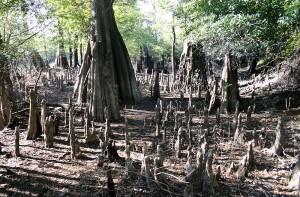Distinctive knobs of the Cypress root system at low water.
Common trade names: Cypress, Southern Cypress, Sunken Cypress
Genus: Taxodium ascendens (Pond), Taxodium distichum (Bald), Taxodium mucronatum (Montezuma)
Janka Hardness (pounds-force): 510
Description: Cypress is an affordable domestic alternatives for applications not requiring an extremely hard wood. Cypress is native to the Southeastern United States, and is marketable in many forms. Cypress is suitable for indoor or outdoor applications, and is a light and mellow brown, with sapwood lightening to a near white. Straight grained with a moderate texure, Cypress is very easy to work. Make sure you keep your tools very sharp to avoid ripping the grain. Very insect and rot resistant.
Location: Southeastern United States
Common Aliases: Cypress refers to any number of species found across several continents. For purposes of our marketable lumbers, Cypress is specifically linked to those found in the Southeastern US.
Performance: Cypress can be easily glued and worked. Keep tools sharp. For fine woodworking applications, cut with the grain to avoid unnecessary tearing. It’s a very good species for a number of uses.
Acclimation: Always stack and space your order upon its reception. This is true for every species we offer due to the local variations in climate.
Common Uses: Outdoor furniture, rain screen siding, shiplap, docks, boatbuilding, interior millworks.
Properties from: The Wood Database
Common Name(s): Cypress, Baldcypress
Scientific Name: Taxodium distichum
Distribution: Southeastern United States
Tree Size: 100 ft (30 m) tall, 3-5 ft (1-1.5 m) trunk diameter
Average Dried Weight: 33 lbs/ft3 (525 kg/m3)
Basic Specific Gravity: .42
Hardness: 510 lbf (2,270 N)
Rupture Strength: 10,600 lbf/in2 (73,100 kPa)
Elastic Strength: 1,440,000 lbf/in2 (9,930 MPa)
Crushing Strength: 6,360 lbf/in2 (43.9 MPa)
Shrinkage: Radial: 3.8%, Tangential: 6.2%, Volumetric: 10.5%, T/R Ratio: 1.6
